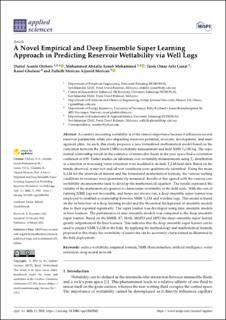| dc.contributor.author | Otchere, Daniel Asante | |
| dc.contributor.author | Mohammed, Mohammed Abdalla Ayoub | |
| dc.contributor.author | Ganat, Tarek Omar Arbi | |
| dc.contributor.author | Gholami, Raoof | |
| dc.contributor.author | Merican, Zulkifli Merican Aljunid | |
| dc.date.accessioned | 2023-01-20T09:36:05Z | |
| dc.date.available | 2023-01-20T09:36:05Z | |
| dc.date.created | 2022-04-09T16:05:52Z | |
| dc.date.issued | 2022 | |
| dc.identifier.citation | Otchere, D. A., Abdalla Ayoub Mohammed, M., Ganat, T. O. A., Gholami, R., & Aljunid Merican, Z. M. (2022). A Novel Empirical and Deep Ensemble Super Learning Approach in Predicting Reservoir Wettability via Well Logs. Applied Sciences, 12(6), 2942. | en_US |
| dc.identifier.issn | 2076-3417 | |
| dc.identifier.uri | https://hdl.handle.net/11250/3044873 | |
| dc.description.abstract | Accurately measuring wettability is of the utmost importance because it influences several reservoir parameters while also impacting reservoir potential, recovery, development, and management plan. As such, this study proposes a new formulated mathematical model based on the correlation between the Amott-USBM wettability measurement and field NMR T2LM log. The exponential relationship based on the existence of immiscible fluids in the pore space had a correlation coefficient of 0.95. Earlier studies on laboratory core wettability measurements using T2 distribution as a function of increasing water saturation were modified to include T2LM field data. Based on the trends observed, water-wet and oil-wet conditions were qualitatively identified. Using the mean T2LM for the intervals of interest and the formulated mathematical formula, the various wetting conditions in existence were quantitatively measured. Results of this agreed with the various core wettability measurements used to develop the mathematical equation. The results expressed the validity of the mathematical equation to characterise wettability at the field scale. With the cost of running NMR logs not favourable, and hence not always run, a deep ensemble super learner was employed to establish a relationship between NMR T2LM and wireline logs. This model is based on the architecture of a deep learning model and the theoretical background of ensemble models due to their reported superiority. The super learner was developed using nine ensemble models as base learners. The performance of nine ensemble models was compared to the deep ensemble super learner. Based on the RMSE, R2, MAE, MAPD and MPD the deep ensemble super learner greatly outperformed the base learners. This indicates that the deep ensemble super learner can be used to predict NMR T2LM in the field. By applying the methodology and mathematical formula proposed in this study, the wettability of reservoirs can be accurately characterised as illustrated in the field deployment. | en_US |
| dc.language.iso | eng | en_US |
| dc.publisher | MDPI | en_US |
| dc.rights | Navngivelse 4.0 Internasjonal | * |
| dc.rights.uri | http://creativecommons.org/licenses/by/4.0/deed.no | * |
| dc.title | A Novel Empirical and Deep Ensemble Super Learning Approach in Predicting Reservoir Wettability via Well Logs | en_US |
| dc.title.alternative | A Novel Empirical and Deep Ensemble Super Learning Approach in Predicting Reservoir Wettability via Well Logs | en_US |
| dc.type | Peer reviewed | en_US |
| dc.type | Journal article | en_US |
| dc.description.version | publishedVersion | en_US |
| dc.rights.holder | The author | en_US |
| dc.subject.nsi | VDP::Matematikk og Naturvitenskap: 400 | en_US |
| dc.source.volume | 12 | en_US |
| dc.source.journal | Applied Sciences | en_US |
| dc.source.issue | 6 | en_US |
| dc.identifier.doi | 10.3390/app12062942 | |
| dc.identifier.cristin | 2016389 | |
| cristin.ispublished | true | |
| cristin.fulltext | original | |
| cristin.qualitycode | 1 | |

